Is Luckenbach a town, a dance hall, or a tourist attraction? Truth be told, it’s a little of all three. There is a general store and post office; a dance hall, consistently recognized as one of Texas’ top ten; and a kitschy landmark. Transcending all generalizations, Luckenbach is a county music gathering place.
We visited Luckenbach the afternoon before a music festival. Dozens of folks prepared for the thousands arriving later in the day. Directed to a field to park, we made our way past weathered-wood ticket booths and onto the grounds. To our left, nailed to a fence, we found the Luckenbach logo and infamous population sign, a popular photo spot.  The population sign, Population 3, often goes missing, stolen by tourists wanting more than a picture to remind them of their visit. Leave the sign in place and buy your souvenirs from the general store, please.
The population sign, Population 3, often goes missing, stolen by tourists wanting more than a picture to remind them of their visit. Leave the sign in place and buy your souvenirs from the general store, please.
Courtyard and outdoor stage
Behind the Luckenbach store you’ll find a courtyard with picnic tables, an outdoor stage, and a rooftop canopy formed by hundreds year-old oaks. This is the heart of the Luckenbach experience. The Picker Circle listed on Luckenbach’s calendar denotes free outdoor entertainment – offered most afternoons. Grab a beer and relax. Enjoy the music, dance, eat, and people watch.
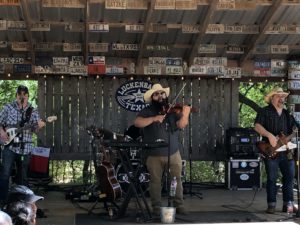 I’m not sure what I enjoyed more – the music from the fiddler onstage or the diversity of people. Remember, Everybody is somebody in Luckenbach. Our fellow visitors included a septuagenarian couple swing dancing in newly purchased cowboy hats; weekend bikers in leathers and bandana doo-rags, and twenty-something women in Daisy Duke shorts and boots. It’s a relaxed, unpretentious vibe.
I’m not sure what I enjoyed more – the music from the fiddler onstage or the diversity of people. Remember, Everybody is somebody in Luckenbach. Our fellow visitors included a septuagenarian couple swing dancing in newly purchased cowboy hats; weekend bikers in leathers and bandana doo-rags, and twenty-something women in Daisy Duke shorts and boots. It’s a relaxed, unpretentious vibe.
The Feed Lot serves typical hamburgers and hot dogs. To the left of the stage is a bar with a remarkable selection of beers, but bring cash (no credit cards).
Post office and hat shop
The post office is also the town general store. Here you get the flavor of a tourist spot with everything from t-shirts to drink ware to guitar picks all embossed with Luckenbach’s logo. With a nod to country music, you’ll also find a nice selection of country music CDs.
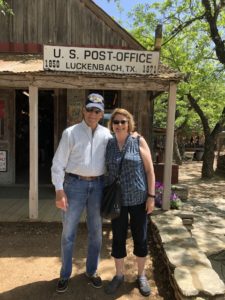 The Snail Creek Hat Company, located behind the store and next to the outdoor stage, offers a unique twist to the traditional western hat. Yes, you can buy the traditional felted hats, but the store specializes in the wide brim, palm leaf variety – half Panama and half cowboy hat.
The Snail Creek Hat Company, located behind the store and next to the outdoor stage, offers a unique twist to the traditional western hat. Yes, you can buy the traditional felted hats, but the store specializes in the wide brim, palm leaf variety – half Panama and half cowboy hat.
History of Luckenbach
In the 1840s German farmers, including Jacob and August Luckenbach, settled the area. The town thrived with a cotton gin and dancehall until the turn of the twentieth century. The town declined in population and opportunity until the 1930s when the dancehall was rebuilt. That rebirth as short lived. By 1960, only about 50 people lived in Luckenbach. Modern day Luckenbach owes its reincarnation to John Russel (Hondo) Crouch. Hondo bought Luckenbach in 1971 and declared himself mayor of the town of three. A humorist and writer, he hosted a Luckenbach World Fair, a women-only chili cook off, and other quirky festivals. And it was Hondo who coined the phrase Everybody is somebody at Luckenbach. Waylon Jennings 1977 song, Luckenbach Texas, sealed the town’s fate as a national icon. Music legends like Willie Nelson and Lyle Lovett popularized the town as a country music destination.
If you go
Luckenbach is about 14 miles from Fredericksburg in Texas Hill Country. The physical address for your map app is 412 Luckenbach Town Loop, Fredericksburg. Most afternoons, you’ll find free country music entertainment on the outdoor stage. Because it is outdoors, weather may be a factor. The oak trees provide some cooling during hot Texas summers, though the ideal time to visit is in spring. Shows, festivals, and dances require tickets. Before you go, check the event calendar. The general store accepts credit cards, the outdoor bar does not.

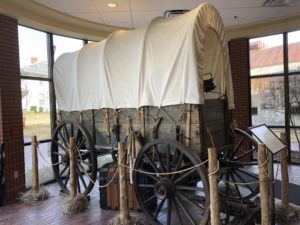 Are you looking for a Sunday family outing? Start with a Texas history appetizer at Frisco Heritage Museum and finish with family dining at Babes Chicken Dinner House.
Are you looking for a Sunday family outing? Start with a Texas history appetizer at Frisco Heritage Museum and finish with family dining at Babes Chicken Dinner House. See smiths use forge and anvil to create nails and other objects, a crowd favorite with young scouts visiting the day of my visit. The Crozier-Sickles house, built in 1895, retains fixtures and furniture from the Crozier family. The old icebox in the kitchen and the hand-crank telephone contrast starkly to today’s refrigerators and smart phones. Other buildings include Lebanon Baptist Church (first built in 1883), a train depot, and a one-room schoolhouse replica.
See smiths use forge and anvil to create nails and other objects, a crowd favorite with young scouts visiting the day of my visit. The Crozier-Sickles house, built in 1895, retains fixtures and furniture from the Crozier family. The old icebox in the kitchen and the hand-crank telephone contrast starkly to today’s refrigerators and smart phones. Other buildings include Lebanon Baptist Church (first built in 1883), a train depot, and a one-room schoolhouse replica.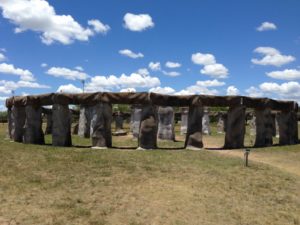 There you’ll find a Stonehenge and two Easter Island Moai head replicas. The structures are the work of two Hill Country residents, Al Shepperd and Doug Hill.
There you’ll find a Stonehenge and two Easter Island Moai head replicas. The structures are the work of two Hill Country residents, Al Shepperd and Doug Hill.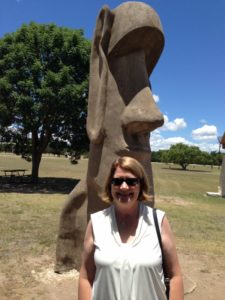 It’s a bucolic spot, with the Guadalupe River just off to the left.
It’s a bucolic spot, with the Guadalupe River just off to the left.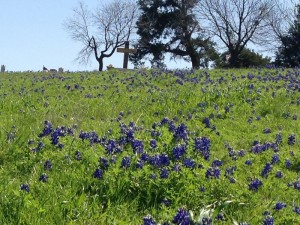 parks near Dallas offer plenty of springtime blooms including fields of bluebonnets! The Facebook page,
parks near Dallas offer plenty of springtime blooms including fields of bluebonnets! The Facebook page,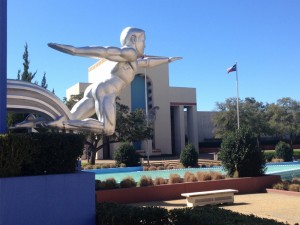 Fair Park is one of Dallas’ most beautiful locations and also one of its most overlooked. If you are like most Dallas residents, you visit Fair Park only once a year during the Texas State Fair. Yet this 227-acre park is open year round. On a sunny day, I find the art and architectural at Fair Park simply breathtaking.
Fair Park is one of Dallas’ most beautiful locations and also one of its most overlooked. If you are like most Dallas residents, you visit Fair Park only once a year during the Texas State Fair. Yet this 227-acre park is open year round. On a sunny day, I find the art and architectural at Fair Park simply breathtaking.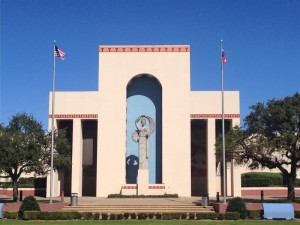 porticos at the Automobile Building and Centennial Hall frame six statues. Each statue represents a nation who, at one time, controlled Texas. Designed by Carlo Ciampaglia (Centennial Hall) and Pierre Bourdelle (Automobile Building), the statues bear the classical look of Greek goddesses.
porticos at the Automobile Building and Centennial Hall frame six statues. Each statue represents a nation who, at one time, controlled Texas. Designed by Carlo Ciampaglia (Centennial Hall) and Pierre Bourdelle (Automobile Building), the statues bear the classical look of Greek goddesses. 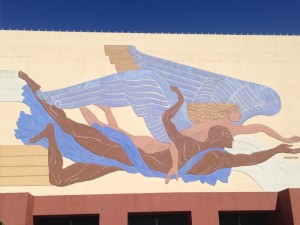 Reliefs on Centennial Hall continue the mythological theme and mix seamlessly with the modernistic murals of industry at the Automobile Building. Recently recreated fountain statues of The Tenor and The Contralto, add another exciting note to the whole Art Deco immersion.
Reliefs on Centennial Hall continue the mythological theme and mix seamlessly with the modernistic murals of industry at the Automobile Building. Recently recreated fountain statues of The Tenor and The Contralto, add another exciting note to the whole Art Deco immersion.